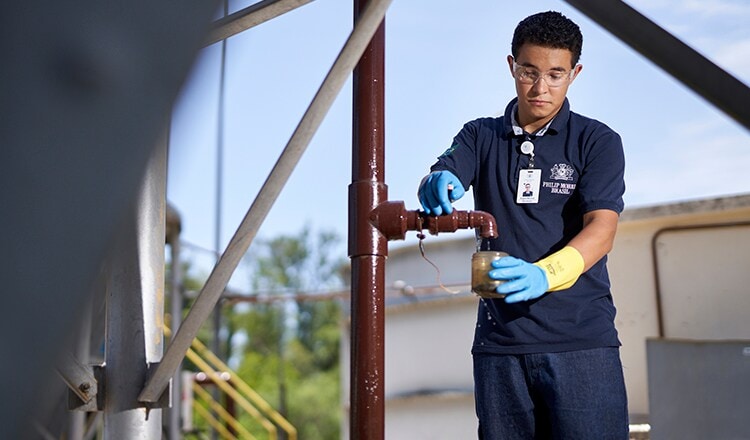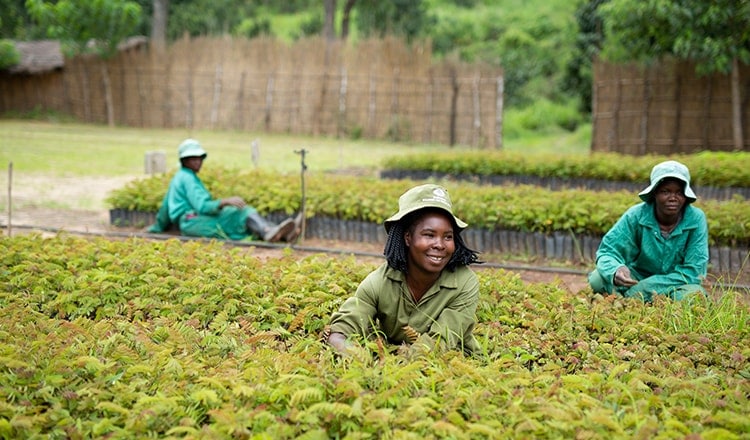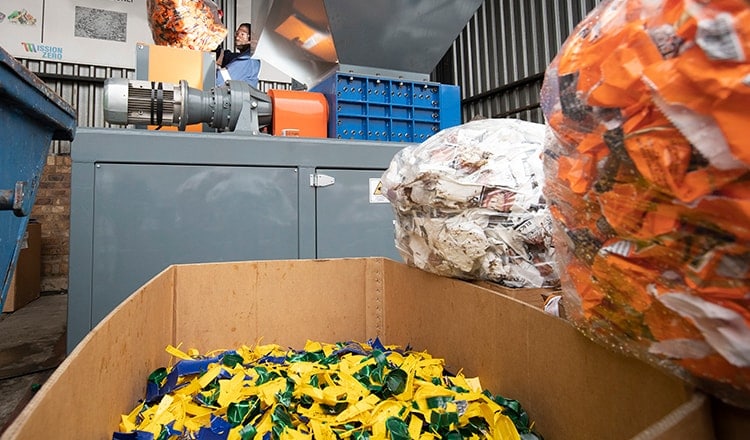| INTEGRATED REPORT 2019 |
Water is a renewable yet limited local resource, which we all share and that is critical to life on the planet. By responsibly managing their impact on water, companies can contribute to mitigating water scarcity and advancing global health and food security. For businesses operating in water-stressed regions, the need for careful water management is considerable and can be exacerbated by the physical impacts of climate change. This is even more so in low- and middle-income countries where access to water, sanitation and hygiene (WASH) is an enabler of economic development.
In this chapter you will find:
Why it is important to us and our stakeholders
The global water crisis we’re experiencing today is characterized by droughts, floods, and localized shortages and has far-reaching consequences. Water is essential to the planet, its ecosystems, and its inhabitants. It is crucial to hygiene and health. A lack of water can also pose a major challenge to economic prosperity, with many activities relying on this resource. Compared with other industries, the tobacco sector is not particularly water-intensive; nevertheless, water security is a business imperative for PMI, and the scale of our business means we can have significant impacts on water resources.
Our products require water, from growing tobacco crops to product manufacturing. Our agricultural supply chain accounts for around half of our water footprint. The second-largest share of our total water use is in the rest of our supply chain, in particular the manufacture of filters, paper, and packaging materials. Our manufacturing facilities account for 6 percent of our footprint, with fresh water used for manufacturing, sanitation, and other processes.
Responsibly managing water strengthens our ability to minimize operational risks. A limited or irregular water supply could impact our ability to source high-quality tobacco leaf and to manufacture our products. Furthermore, access to adequate and safe water, sanitation, and hygiene services in the communities surrounding our operations and in our supply chain helps to protect workers and their families’ health, livelihoods, and productivity.
Achieving our aims
Water stewardship describes our approach to responsibly managing water across our value chain. Our vision is to preserve water resources and respect the natural cycle of water, working in close cooperation with our stakeholders. We aim to optimize water consumption in our operations, reduce the water footprint of our products, and adequately treat the wastewater from our factories. We strive to understand our operational water use and impacts, and to work collaboratively and transparently with stakeholders to ensure sustainable water management within a catchment context. To this end, our target is to have all our factories certified by the Alliance for Water Stewardship (AWS) standard by 2025, with six already certified as of the end of 2019. As of the end of 2019, 98 percent of our manufacturing facilities were certified to the ISO 14001 standard.
In our tobacco supply chain, we are committed to preserving water resources, safeguarding both water quantity and quality. A key focus is also to enable community access to drinking water, sanitation, and hygiene (WASH) in the areas where we source tobacco. PMI is committed to helping ensure that 100 percent of tobacco farmers directly or indirectly supplying tobacco to PMI have access to improved sources of water by 2025 and access to basic sanitation and hygiene by 2030.
Our company-wide Environmental Commitment and Water Stewardship policy guides our work in this area. It is complemented by internal standards for our operations – our Responsible Sourcing Principles (RSP) for suppliers and our Good Agricultural Practices (GAP) Code in our tobacco supply chain. We rely on our procurement, sourcing, and manufacturing teams and work with our suppliers and farmers to deliver our commitments on the ground. In our tobacco supply chain, the field technicians employed by PMI or our third-party suppliers are instrumental in helping farmers reduce water consumption while improving yields.
Accurate measurement of our water footprint and understanding of water-related risks allow us to adapt our actions. In both our operations and tobacco leaf supply chain, we use external and internal data to shape our strategy and identify appropriate interventions.
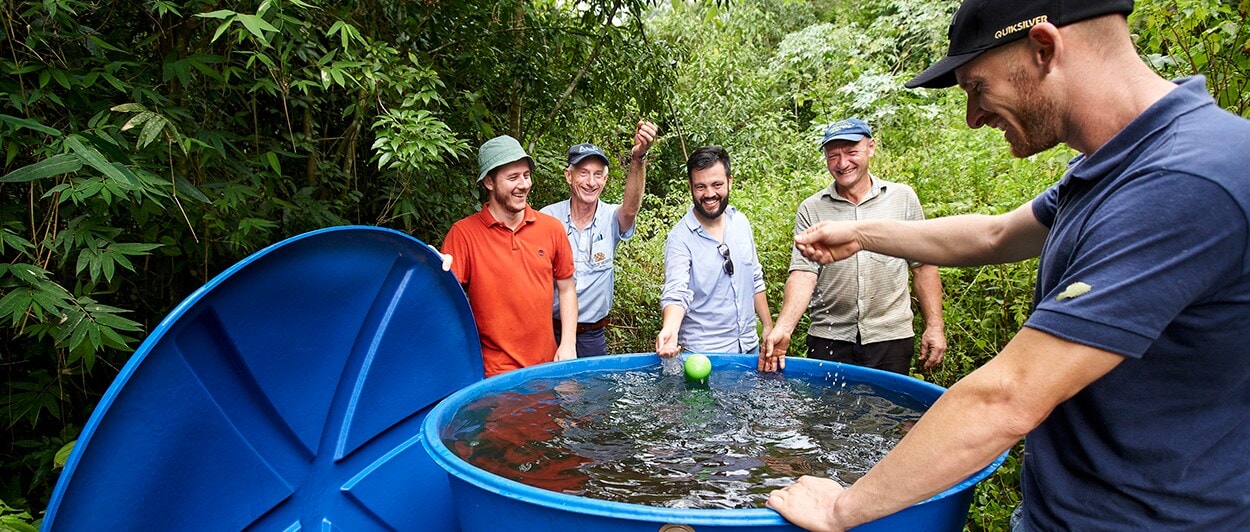
Progress in 2019
Water stewardship in our tobacco supply chain
Fresh water is essential to agricultural production. Achieving the best crop results requires the timely application and proper use of water. Our GAP program requires a water management plan to be in place to manage irrigation efficiently and reduce water pollution risks. We also aim for the local communities in the regions we source tobacco from to have access to adequate clean water for drinking, cooking, personal hygiene, and cleaning purposes.
Water risks in our tobacco supply chain
Our global water risk assessment, updated annually using the World Resources Institute’s Aqueduct risk-mapping tool, analyzes physical water risks in all the tobacco-growing areas from which we source and indicates patterns to expect over the coming years.
Globally, the 2019 assessment revealed that 57 percent of all tobacco-growing areas show a “medium to high,” “high,” or “extremely high” level of physical risk. This means those regions are at risk of water scarcity, flooding, and/or water pollution. This assessment is not tailored specifically to the tobacco-growing areas; rather, it’s based on geographic regions, so the risk factors are indicative of a more complex scenario beyond tobacco cultivation alone. With this caveat in mind, the main concern is centered on some areas of South Africa, which face extremely high overall physical water risk. Almost all other growing areas in Africa also face a risk of seasonal variability and flooding. Our 2019 assessment also showed that tobacco-growing areas in Indonesia, India, and Turkey have a significant level of risk overall.
Modeling water risk over a 20-year span for the areas from which we source tobacco, we project that water stress will increase to some extent. Further, our scenario analysis suggests the water supply may decrease in close to half of our tobacco-growing areas by 2040, with some increases in seasonal variability of the water supply.
Data analyzed during our global water risk assessment also provided insights into communities’ access to water, sanitation, and hygiene. It showed that countries in Africa have the greatest WASH-related risks. In addition, Indonesia, India, the Philippines, Colombia, and Brazil show high risks, particularly in terms of lack of access to appropriate sanitation in rural areas.
Local water risk assessments complement the global exercise with locally available data sources, existing supplier knowledge of risks, and local insights into relevant contextual factors. Those local assessments also take into account the monitoring information collected by the field technicians.
The findings from our risk assessments help identify areas where we can have the greatest impact in addressing local issues. They inform our strategy and guide our interventions on the ground, which we deliver in partnership with our suppliers and farmers so as to manage this scarce resource efficiently. In 2019, our main actions focused primarily on evaluating improvements in irrigation systems brought about by switching to water-saving technologies, measuring the benefits of using sound methodologies, and employing sensor monitoring where possible. Countries of focus were Indonesia, for clove cultivation, as well as the Philippines and Spain for tobacco. Since 2018, we conducted 15 local water-risk assessments.
Irrigation in agriculture
Half of the water used to grow the tobacco we source comes from rainfall, while the other half comes from irrigation. In 2019, irrigation represented an average of 317 cubic meters of water per ton of tobacco produced.
The quantity, quality, and timing of water availability through rainfall and irrigation all have an impact on the growth of the tobacco plant. In light of the various risk profiles around the world, irrigation is at the core of water stewardship in agriculture. We source tobacco in rain-fed areas where the rain season matches with the growing season, and, where we use irrigation, we seek to conduct local risk assessments to evaluate the risk of baseline water stress.
Irrigation systems leverage different technologies depending on the local contexts, needs, and resource availability. Tropical countries widely use open-air channel irrigation, while in the Veneto region in Italy, for instance, highly efficient drip-irrigation systems are used to grow about 98 percent of the tobacco we purchase there. Precision irrigation through cutting-edge technology helps us to reduce water use.
Farmers who diversify also must understand the water demands of alternative crops. We work with them to analyze crop-specific water use and to facilitate the transition to new crops by maximizing the efficiency of the system while monitoring the environmental impact.
Water quality
A risk of pollution results from the potential misuse of crop protection agents (CPAs) and fertilizers. While fertilizers improve crop growth and CPAs protect crops, these chemicals can enter groundwater or watercourses, impacting aquatic ecosystems.
We have a global integrated pest management (IPM) program in place to reduce the use of unnecessary pesticides, promote the use of less hazardous alternatives, and manage them appropriately. Field technicians are key to achieving our goals. Their interventions generate improvements in pesticide and fertilizer management as part of our GAP program. In 2019, they continued to run trainings to help farmers avoid negative environmental impacts and unnecessary financial burdens. For more information, refer to our biodiversity section.
Access to water, sanitation, and hygiene
In the rural areas of emerging countries from which we source tobacco, particularly where there is no water infrastructure around the tobacco fields, we focus on improving community access to water, sanitation, and hygiene. WASH is a basic human right, and we consider it our responsibility to help secure it.
We design the monitoring approach to measure our progress against the following criteria:
- Water – Access to drinking water from a source protected from outside contamination, such as a public tap or an improved borehole, with no more than a 30-minute collection time for a round trip from home.
- Sanitation – Access to improved sanitation facilities, such as septic tanks or composting toilets, that are not shared with other households. Such facilities can be shared when at work, provided enough are accessible.
- Hygiene – The availability of handwashing facilities at home and work, including soap and water.
An example of a community water initiative we have undertaken is a pilot project carried out in Malawi (read more here).
Water stewardship in manufacturing
Manufacturing cigarettes and smoke-free-product consumables at PMI accounts for 6 percent of our total water footprint, amounting to around 4 million cubic meters in 2019. Three main goals drive water management within our factories: First, we must maintain water quality and safety; second, we must reduce consumption; and third, we must rapidly deploy cost-effective water and wastewater technologies.
Water efficiency in manufacturing
Most of our factory water is sourced from municipalities and groundwater and is used to increase tobacco moisture content, as well as for cleaning and cooling. We use the WRI Aqueduct tool to identify factories located in geographies facing water stress and account for the water withdrawn from these sites. Based on this assessment, 54 percent of our direct factory water withdrawals in 2019 were from water-stressed areas, which is higher than in 2018, when 30 percent were from water-stressed areas. The increase is due to the higher production volume of our smoke-free products, which require around five times more water than our conventional cigarettes that are based on water scarcity areas. These assessments allow us to identify the priority factories at which we will implement water-efficiency interventions.
By 2025, PMI aspires for its smoke-free products to account for at least 30 percent of total shipment volume, which will have an impact on water use. As of 2019, a total of eight PMI factories were partially or fully converted to produce smoke-free products. These higher water needs increase risk, particularly in water-stressed regions. To mitigate these and any other water-related risks, we are implementing the AWS standard in all our factories.
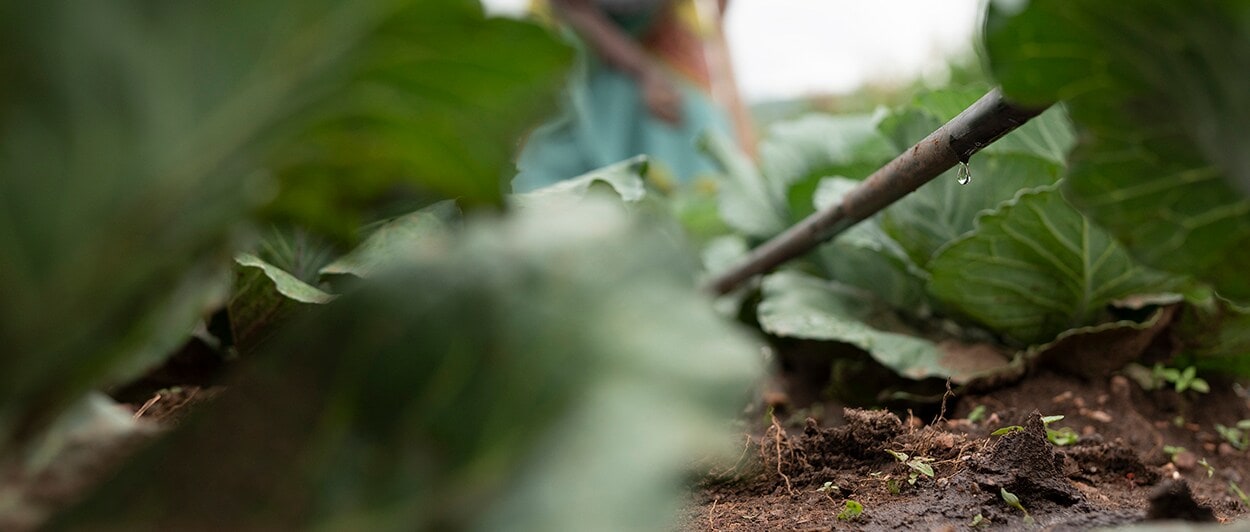
Alliance for Water Stewardship
Water stewardship at our manufacturing sites is achieved through internal investment in water performance and community engagement in line with the AWS standard. AWS helps us to understand better how to manage water at catchment level. Our goal is to certify all our factories to the AWS standard by 2025.
In 2018, AWS certified our first factory, in Brazil. In 2019, we completed five more certifications, in Indonesia, Italy, Portugal, Russia, and Turkey. Following the upgrade of the AWS standard to include WASH aspects, our factory at Santa Cruz do Sul in Brazil was the first of any facility worldwide to be certified to the new AWS 2.0 standard.
Also in 2019, we gathered our experts in water stewardship at our factory in Greece to discuss the challenges faced in the communities in which we operate. In addition to working together to design our global strategy, participants underwent AWS specialist official accreditation training from SGS Training Academy. Twenty experts passed the certification to become internal AWS auditors, a key milestone that will facilitate the rollout of the AWS program across all our factories.
We also are evolving how we recycle and reuse water. We expect the volumes of recycled water to increase in all our factories as water efficiency and conservation initiatives are expanded.
To decrease our water footprint, we are installing state-of-the-art technology for wastewater treatment and reuse. These systems are based on filtration, physicochemical, biological, membrane, advanced oxidation, adsorption, and electrolytic treatment technologies. As an example of our progress, our smoke-free products factory in Bologna, Italy, improved its water efficiency rate1 by 18 percent in 2019 versus the previous year. Several water-saving initiatives contributed to this, including the purification of 128,000 cubic meters (equivalent to 50 Olympic-size swimming pools) of treated wastewater with reverse osmosis for reuse in cooling processes and steam production. We aim to go further and reclaim water for equipment cleaning operations. Because direct reuse is hampered by high mineral content, we are installing dedicated electrodialysis desalination technology to greatly reduce the water rejection inherent in purification technologies while decreasing costs, chemicals, and energy consumption. We will also attempt the direct reuse of rejected water from reverse osmosis in cooling towers, using (already installed) electrolytic technology.
Next steps
In our tobacco supply chain, we aim to conduct 22 local water-risk assessments by the end of 2020 to complete the mapping of the most relevant countries we source tobacco from.
We will continue with AWS certification and plan to certify five to 10 factories a year until they are complete (no later than 2025). In 2020, we are targeting five sites, in Greece, Korea, Mexico, Poland, and Romania.
We will implement additional efficiency and water-reuse projects at our factories as we continue to invest in water technologies and pilot new projects, and will detail our progress in future reports.
This online supplement to our integrated report should be read in conjunction with PMI’s Integrated Report 2019. The information and data presented in this online supplement cover the 2019 calendar year or reflect status at December 31, 2019, worldwide, unless otherwise indicated. Where not specified, data come from PMI estimates. See About this online supplement for more information. Aspirational targets and goals do not constitute financial projections, and achievement of future results is subject to risks, uncertainties and inaccurate assumptions, as outlined in our forward-looking and cautionary statements.


